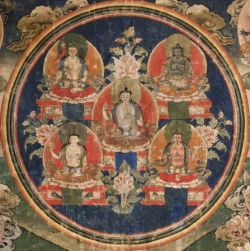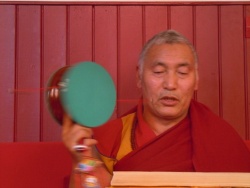Difference between revisions of "History of Bön"
m (Text replacement - "prince" to "{{Wiki|prince}}") |
m (Text replacement - "]]]" to "]])") |
||
| Line 13: | Line 13: | ||
[[Bön]] as it is practiced now, known as "[[New Bön]]," is [[essentially]] a [[form]] of [[Tibetan Buddhism]]. It began in the 14th century when some [[Bön]] [[teachers]] began to adopt [[Tibetan Buddhist]] practices related to [[Padmasambhava]]. Although [[New Bön]] differs considerably from [[Yungdrun Bön]], the practitioners of [[New Bön]] regard their [[religion]] as part of a continuous [[Bön]] [[tradition]] that includes the prior stages. According to the Oxford {{Wiki|Dictionary}} of [[World]] [[Religions]], however, "any connection between ancient and {{Wiki|modern}} [[Bön]] is extremely tenuous." | [[Bön]] as it is practiced now, known as "[[New Bön]]," is [[essentially]] a [[form]] of [[Tibetan Buddhism]]. It began in the 14th century when some [[Bön]] [[teachers]] began to adopt [[Tibetan Buddhist]] practices related to [[Padmasambhava]]. Although [[New Bön]] differs considerably from [[Yungdrun Bön]], the practitioners of [[New Bön]] regard their [[religion]] as part of a continuous [[Bön]] [[tradition]] that includes the prior stages. According to the Oxford {{Wiki|Dictionary}} of [[World]] [[Religions]], however, "any connection between ancient and {{Wiki|modern}} [[Bön]] is extremely tenuous." | ||
| − | It is commonly believed that [[Tibetan Buddhism]] was shaped by [[Bön]], but the Oxford {{Wiki|Dictionary}} refutes this as well. "Contrary to the popular misconception that [[Buddhism]] was significantly influenced by [[Bön]] when it entered [[Tibet]], it is clear that what is known of [[Bön]] today is almost completely influenced by [[Mahayana Buddhism]], which was itself transplanted from [[India]] into [[Tibet]] virtually unchanged." 6 The [[Dalai Lama]]o is supportive of [[Bön]], shares a similar perspective: "In its beginning, I believe, it [[[Bön]] | + | It is commonly believed that [[Tibetan Buddhism]] was shaped by [[Bön]], but the Oxford {{Wiki|Dictionary}} refutes this as well. "Contrary to the popular misconception that [[Buddhism]] was significantly influenced by [[Bön]] when it entered [[Tibet]], it is clear that what is known of [[Bön]] today is almost completely influenced by [[Mahayana Buddhism]], which was itself transplanted from [[India]] into [[Tibet]] virtually unchanged." 6 The [[Dalai Lama]]o is supportive of [[Bön]], shares a similar perspective: "In its beginning, I believe, it [[[Bön]]) was not such a fruitful [[religion]], but when [[Buddhism]] began to flourish in [[Tibet]], [[Bön]] also had an opportunity to enrich its own [[religious]] [[philosophy]] and [[meditational]] resources." |
Today, [[Bön]] can be found in the more isolated parts of northern and western [[Tibet]], as well as in exile at the [[Tashi Menri Ling]] [[Monastery]] in Dolanji in [[Himachal Pradesh]], [[India]]. The current leader of [[Bön]] is [[His Holiness]] [[Lungtok Tenpai Nyima]]. | Today, [[Bön]] can be found in the more isolated parts of northern and western [[Tibet]], as well as in exile at the [[Tashi Menri Ling]] [[Monastery]] in Dolanji in [[Himachal Pradesh]], [[India]]. The current leader of [[Bön]] is [[His Holiness]] [[Lungtok Tenpai Nyima]]. | ||
Revision as of 14:17, 3 April 2016
Both scholars and the Bönpo themselves distinguish between original Bön and modern Bön. "Original Bön" refers to the indigenous religion of Tibet, which was animistic (believing that nature is pervaded by good and evil spirits) and shamanistic. The name was probably derived from the ritual recitation (Bön, meaning "invocation") of its practitioners.
The exact nature of original Bön is difficult to determine, since all early descriptions of it are from the Buddhist perspective and intended to discredit it. After the first diffusion of Buddhism into Tibet in the 7th century, Bön was persecuted under Buddhist rulers, but it survived and became more organized at the time of the second diffusion of Buddhism in the 11th century.
The Bönpo teach a second stage of Bön, which scholars generally dismiss, called Yungdrung Bön. This stage of Bön is said to have been founded by a Buddha-like figure named Shenrab Miwoche, who lived 18,000 years ago in a mythical land of Zhang Zhung near Tibet.
Like the Buddha, Shenrab renounced his life as a prince to become a monk, achieved enlightenment, and taught others how to attain it. He thus converted the people from animistic Bön to Yungdrung ("eternal") Bön. The claim, therefore, is that Bön incorporated Buddhist-like elements prior to and apart from the influence of Buddhism.
Alternatively, Tibetan Buddhist scholars have identified Shenrab with Lao-Tzu, making Bön a derivative of Taoism. Modern scholars have also suggested Shaivite (Hindu sect devoted to Shiva) influence from Kashmir in the development of Bön.
Bön as it is practiced now, known as "New Bön," is essentially a form of Tibetan Buddhism. It began in the 14th century when some Bön teachers began to adopt Tibetan Buddhist practices related to Padmasambhava. Although New Bön differs considerably from Yungdrun Bön, the practitioners of New Bön regard their religion as part of a continuous Bön tradition that includes the prior stages. According to the Oxford Dictionary of World Religions, however, "any connection between ancient and modern Bön is extremely tenuous."
It is commonly believed that Tibetan Buddhism was shaped by Bön, but the Oxford Dictionary refutes this as well. "Contrary to the popular misconception that Buddhism was significantly influenced by Bön when it entered Tibet, it is clear that what is known of Bön today is almost completely influenced by Mahayana Buddhism, which was itself transplanted from India into Tibet virtually unchanged." 6 The Dalai Lamao is supportive of Bön, shares a similar perspective: "In its beginning, I believe, it [[[Bön]]) was not such a fruitful religion, but when Buddhism began to flourish in Tibet, Bön also had an opportunity to enrich its own religious philosophy and meditational resources."
Today, Bön can be found in the more isolated parts of northern and western Tibet, as well as in exile at the Tashi Menri Ling Monastery in Dolanji in Himachal Pradesh, India. The current leader of Bön is His Holiness Lungtok Tenpai Nyima.
According to the Chinese census, about 10% of Tibetans (about 100,000 people) follow Bön. At the time of the communist takeover there were approximately 300 Bön monasteries in Tibet and western China. According to a recent survey, there are 264 active Bön monasteries, nunneries, and hermitages.

